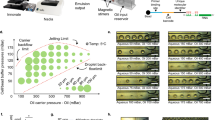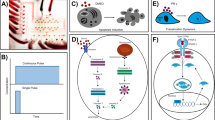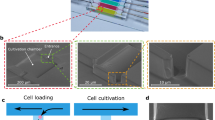Abstract
Heterogeneity in cell populations poses a major obstacle to understanding complex biological processes. Here we present a microfluidic platform containing thousands of nanoliter-scale chambers suitable for live-cell imaging studies of clonal cultures of nonadherent cells with precise control of the conditions, capabilities for in situ immunostaining and recovery of viable cells. We show that this platform mimics conventional cultures in reproducing the responses of various types of primitive mouse hematopoietic cells with retention of their functional properties, as demonstrated by subsequent in vitro and in vivo (transplantation) assays of recovered cells. The automated medium exchange of this system made it possible to define when Steel factor stimulation is first required by adult hematopoietic stem cells in vitro as the point of exit from quiescence. This technology will offer many new avenues to interrogate otherwise inaccessible mechanisms governing mammalian cell growth and fate decisions.
This is a preview of subscription content, access via your institution
Access options
Subscribe to this journal
Receive 12 print issues and online access
$259.00 per year
only $21.58 per issue
Buy this article
- Purchase on Springer Link
- Instant access to full article PDF
Prices may be subject to local taxes which are calculated during checkout





Similar content being viewed by others
Change history
03 June 2011
In the version of this article initially published online, Michelle Miller's name was incorrect. The errors have been corrected for the PDF and HTML versions of this article.
References
Kent, D.G. et al. Prospective isolation and molecular characterization of hematopoietic stem cells with durable self-renewal potential. Blood 113, 6342–6350 (2009).
Dykstra, B. et al. Long-term propagation of distinct hematopoietic differentiation programs in vivo. Cell Stem Cell 1, 218–229 (2007).
Yamazaki, S. & Nakauchi, H. Insights into signaling and function of hematopoietic stem cells at the single-cell level. Curr. Opin. Hematol. 16, 255–258 (2009).
Dykstra, B. et al. High-resolution video monitoring of hematopoietic stem cells cultured in single-cell arrays identifies new features of self-renewal. Proc. Natl. Acad. Sci. USA 103, 8185–8190 (2006).
Kent, D.G., Dykstra, B.J., Cheyne, J., Ma, E. & Eaves, C.J. Steel factor coordinately regulates the molecular signature and biologic function of hematopoietic stem cells. Blood 112, 560–567 (2008).
Brummendorf, T.H., Dragowska, W., Zijlmans, J., Thornbury, G. & Lansdorp, P.M. Asymmetric cell divisions sustain long-term hematopoiesis from single-sorted human fetal liver cells. J. Exp. Med. 188, 1117–1124 (1998).
Audet, J., Miller, C.L., Eaves, C.J. & Piret, J.M. Common and distinct features of cytokine effects on hematopoietic stem and progenitor cells revealed by dose-response surface analysis. Biotechnol. Bioeng. 80, 393–404 (2002).
Schroeder, T. Asymmetric cell division in normal and malignant hematopoietic precursor cells. Cell Stem Cell 1, 479–481 (2007).
Lutolf, M.P., Doyonnas, R., Havenstrite, K., Koleckar, K. & Blau, H.M. Perturbation of single hematopoietic stem cell fates in artificial niches. Integr. Biol. 1, 59–69 (2009).
Balagadde, F.K., You, L.C., Hansen, C.L., Arnold, F.H. & Quake, S.R. Long-term monitoring of bacteria undergoing programmed population control in a microchemostat. Science 309, 137–140 (2005).
Taylor, R.J. et al. Dynamic analysis of MAPK signaling using a high-throughput microfluidic single-cell imaging platform. Proc. Natl. Acad. Sci. USA 106, 3758–3763 (2009).
El-Ali, J., Sorger, P.K. & Jensen, K.F. Cells on chips. Nature 442, 403–411 (2006).
Faley, S.L. et al. Microfluidic single cell arrays to interrogate signalling dynamics of individual, patient-derived hematopoietic stem cells. Lab Chip 9, 2659–2664 (2009).
Wang, Z.H., Kim, M.C., Marquez, M. & Thorsen, T. High-density microfluidic arrays for cell cytotoxicity analysis. Lab Chip 7, 740–745 (2007).
Figallo, E. et al. Micro-bioreactor array for controlling cellular microenvironments. Lab Chip 7, 710–719 (2007).
Kim, L., Vahey, M.D., Lee, H.Y. & Voldman, J. Microfluidic arrays for logarithmically perfused embryonic stem cell culture. Lab Chip 6, 394–406 (2006).
Korin, N., Bransky, A., Dinnar, U. & Levenberg, S. Periodic “flow-stop” perfusion microchannel bioreactors for mammalian and human embryonic stem cell long-term culture. Biomed. Microdevices 11, 87–94 (2009).
Lee, P.J., Hung, P.J., Rao, V.M. & Lee, L.P. Nanoliter scale microbioreactor array for quantitative cell biology. Biotechnol. Bioeng. 94, 5–14 (2006).
Paguirigan, A.L. & Beebe, D.J. From the cellular perspective: exploring differences in the cellular baseline in macroscale and microfluidic cultures. Integr. Biol. 1, 182–195 (2009).
Unger, M.A., Chou, H.P., Thorsen, T., Scherer, A. & Quake, S.R. Monolithic microfabricated valves and pumps by multilayer soft lithography. Science 288, 113–116 (2000).
Thorsen, T., Maerkl, S.J. & Quake, S.R. Microfluidic large-scale integration. Science 298, 580–584 (2002).
Berthier, E., Warrick, J., Yu, H. & Beebe, D.J. Managing evaporation for more robust microscale assays. Part 1. Volume loss in high throughput assays. Lab Chip 8, 852–859 (2008).
Regehr, K.J. et al. Biological implications of polydimethylsiloxane-based microfluidic cell culture. Lab Chip 9, 2132–2139 (2009).
Heo, Y.S. et al. Characterization and resolution of evaporation-mediated osmolality shifts that constrain microfluidic cell culture in poly(dimethylsiloxane) devices. Anal. Chem. 79, 1126–1134 (2007).
Hansen, C.L., Classen, S., Berger, J.M. & Quake, S.R. A microfluidic device for kinetic optimization of protein crystallization and in situ structure determination. J. Am. Chem. Soc. 128, 3142–3143 (2006).
Ma, N.N., Koelling, K.W. & Chalmers, J.J. Fabrication and use of a transient contractional flow device to quantify the sensitivity of mammalian and insect cells to hydrodynamic forces. Biotechnol. Bioeng. 80, 428–437 (2002).
Pineault, N., Abramovich, C. & Humphries, R.K. Transplantable cell lines generated with NUP98-Hox fusion genes undergo leukemic progression by Meis1 independent of its binding to DNA. Leukemia 19, 636–643 (2005).
Ohta, H. et al. Near-maximal expansions of hematopoietic stem cells in culture using NUP98-HOX fusions. Exp. Hematol. 35, 817–830 (2007).
Bowie, M.B., Kent, D.G., Copley, M.R. & Eaves, C.J. Steel factor responsiveness regulates the high self-renewal phenotype of fetal hematopoietic stem cells. Blood 109, 5043–5048 (2007).
Satyanarayana, S., Karnik, R.N. & Majumdar, A. Stamp-and-stick room-temperature bonding technique for microdevices. J. Microelectromech. Syst. 14, 392–399 (2005).
Acknowledgements
We thank M. Gasparetto for assistance with cell sorting and F. Kuchenbauer (Terry Fox Laboratory) for providing the ND13 cell line. This work was supported by grants from the Canadian Institutes of Health Research (MOP-93571 and RMF-82499) and the Natural Sciences and Engineering Research Council of Canada (RGPIN 312140). Infrastructure support was provided by the Canada Foundation for Innovation, Genome British Columbia, Western Diversification Canada and the Terry Fox Foundation. V.L. was supported by Natural Sciences and Engineering Research Council of Canada (Canada Graduate Scholarship) and the Michael Smith Foundation for Health Research (Junior Graduate Studentship). C.L.H. was supported by Michael Smith Foundation for Health Research (Biomedical Scholar) and Canadian Insitutes of Health Research (MSH-95337).
Author information
Authors and Affiliations
Contributions
V.L., S.S., M.M., D.J.H.F.K., S.W., C.J.E., R.K.H., J.M.P. and C.L.H. designed the research. V.L. performed microscale experiments. V.L., S.S., D.J.H.F.K., S.W. and M.M. performed macroscale cultures. S.S. performed in vivo assays. V.L., T.M., W.B. and C.L.H. designed and fabricated microfluidic cell culture arrays. V.L., M.V. and W.B. developed automated image acquisition. M.V., W.B. and F.V. wrote image and data analysis scripts. V.L., S.S., M.M., M.V., D.J.H.F.K., S.W. and W.B. analyzed data. A.J., J.M.P. and F.T. did modeling studies. V.L., T.M., W.B., D.F., A.K.W. and C.L.H. contributed to technology development. M.M., S.S., D.J.H.F.K., S.W., D.G.K., M.R.C., C.J.E. and R.K.H. provided cells, reagents and analytical tools. V.L., S.S., M.V., A.J., W.B., C.J.E., R.K.H., J.M.P. and C.L.H. wrote the manuscript.
Corresponding author
Ethics declarations
Competing interests
The authors declare no competing financial interests.
Supplementary information
Supplementary Text and Figures
Supplementary Figures 1–11, Supplementary Notes 1–4 (PDF 2041 kb)
Supplementary Software 1
Image analysis scripts. (ZIP 18 kb)
Supplementary Video 1
Medium exchange does not disturb the spatial position of the cells. Cells were imaged continuously (1 frame s−1) during 10 min with and without medium exchange. (MOV 9139 kb)
Supplementary Video 2
Recovery of individual colonies. Colonies of ND13 cells were recovered from the microfluidic cell culture array using a micropipette after 72 h in culture. (MOV 7526 kb)
Rights and permissions
About this article
Cite this article
Lecault, V., VanInsberghe, M., Sekulovic, S. et al. High-throughput analysis of single hematopoietic stem cell proliferation in microfluidic cell culture arrays. Nat Methods 8, 581–586 (2011). https://doi.org/10.1038/nmeth.1614
Received:
Accepted:
Published:
Issue Date:
DOI: https://doi.org/10.1038/nmeth.1614
This article is cited by
-
Reliable cell retention of mammalian suspension cells in microfluidic cultivation chambers
Scientific Reports (2023)
-
Rapid response through the entrepreneurial capabilities of academic scientists
Nature Nanotechnology (2022)
-
Open-source personal pipetting robots with live-cell incubation and microscopy compatibility
Nature Communications (2022)
-
A microfluidic platform for highly parallel bite by bite profiling of mosquito-borne pathogen transmission
Nature Communications (2021)
-
Novel invasion indices quantify the feed-forward facilitation of tumor invasion by macrophages
Scientific Reports (2020)



